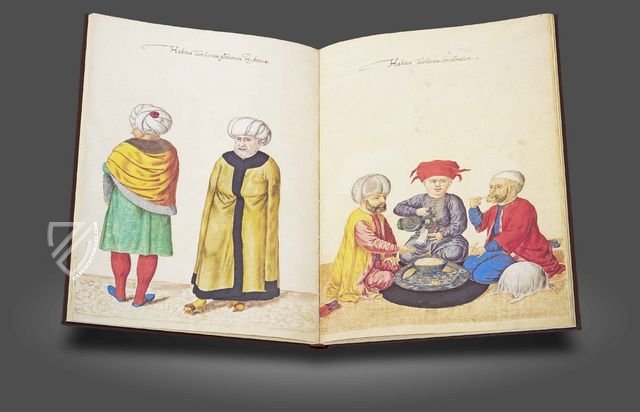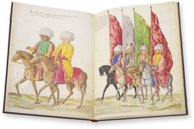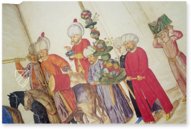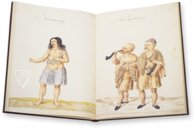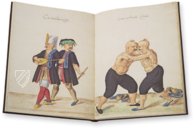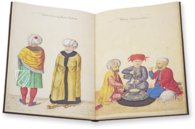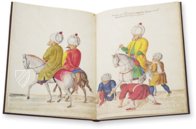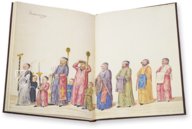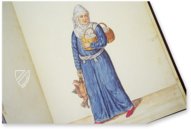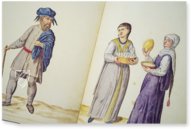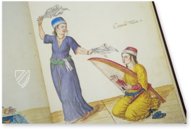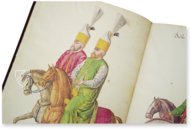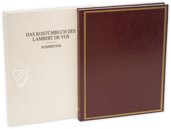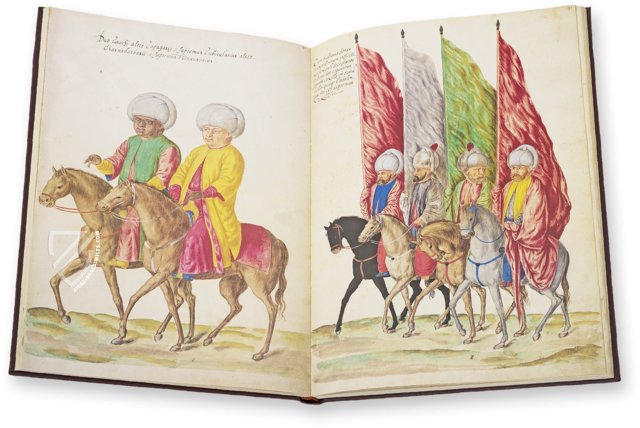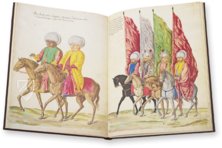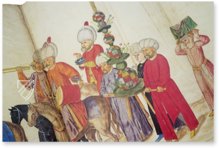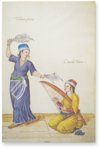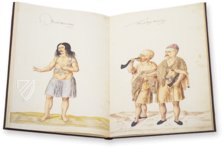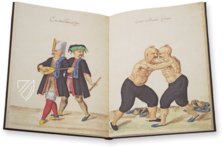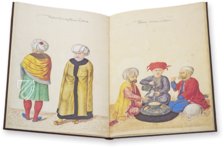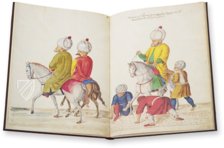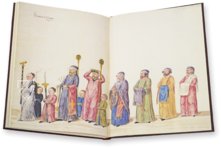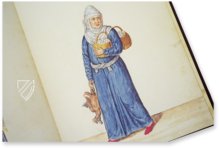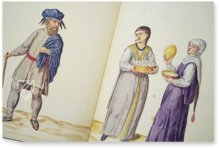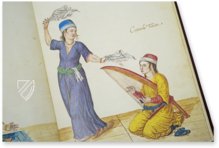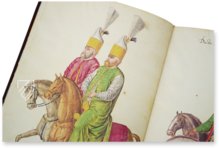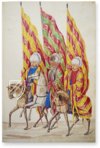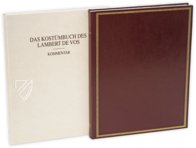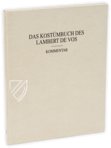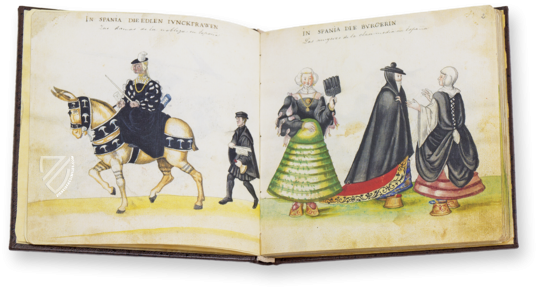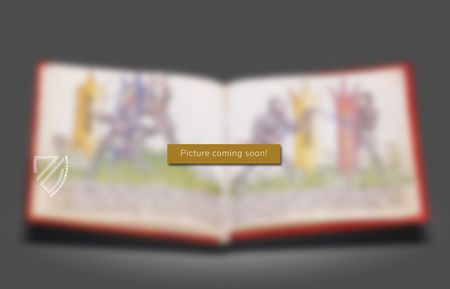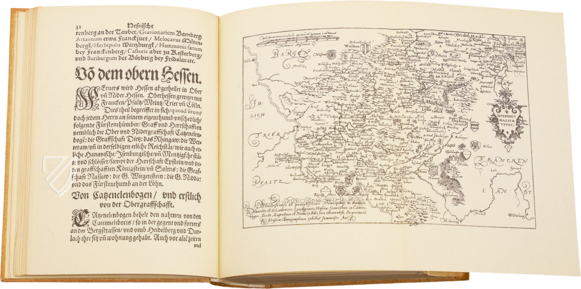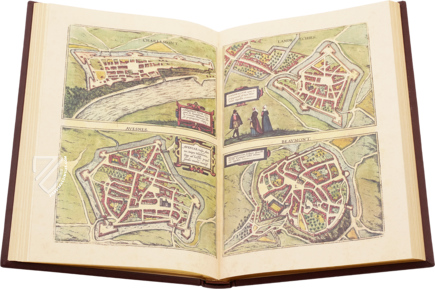The Costume Book of Lambert de Vos
(1,000€ - 3,000€)
One of the most beautiful testimonies to the intercultural relations between the Christian-dominated Europe and the Muslim Ottoman Empire is today housed in the Bremen State and University Library under the shelfmark Ms. or. 9. It contains 103 large-format, richly detailed and splendidly colored depictions of a royal procession and shows the dress of the Ottomans and the various ethnic groups under their rule. The codex was created in 1574 by Lambert de Vos (ca. 1538 – nach 1574), the court painter to the Habsburg ambassador in Constantinople, Karel Rijm (1533–1584). The valuable manuscript was written at a time when the so-called "Turkish Threat" resulting from the imperial policy of the Ottoman Empire was at its greatest for Europe and reflects the enormous extent of the reciprocal effects between the Orient and the Occident at this time. As almost all strata of society are reflected in the images, the work is a useful treasure trove for cultural and art historians alike.
The Costume Book of Lambert de Vos
The Costume Book of Lambert de Vos is one of the most precious testimonies to the reciprocal relations between Orient and Occident in the 16th century. In early modern Europe, interest in the politics, society and military of the Ottoman Empire grew, not least due to its increasing imperial policy. After the fall of the Byzantine or Eastern Roman Empire in 1453, the Ottoman sultans sought to expand their dominion to the north and west. This resulted in the so-called Ottoman Wars, which the sultans waged against European states between the 15th and 19th centuries. In Europe, enemy images of the invaders quickly became established, but this was accompanied by a fascination with the culture of the "new power ".
A Precious Specimen of a Fascinating Genre
This interest in the Ottoman society is probably most colorfully reflected in the so-called "Turkish costume books ", which formed a genre of their own in Europe from the 16th century onwards. The numerous accounts by travelers, merchants and diplomats fuelled the desire for pictorial representations of the stories told. To this day, around 120 manuscript costume books or parts of them have survived. Of these, the Bremen example is one of the best preserved and particularly magnificently furnished. It is particularly renowned for its portrait of Sultan Selim II (1524–1574) and the huge bridal procession made up of several leaves, which can be folded out.
The Ottoman Society from the Perspective of a Fleming
The manuscript's excellently documented origin is also remarkable: an entry by the artist proves that it was created in 1574 by Lambert de Vos (around 1538 – after 1574) for the Imperial Ambassador in Constantinople Karel Rijm (1533–1584). Little is known about the Flemish illuminator himself. De Vos probably came from Mechelen and was in Constantinople from around 1572, where he was associated with diplomats and envoys for whom he illuminated a number of codices.
He decorated the Costume Book for the ambassador with 103 full-page depictions of members of the Ottoman society, especially those from Constantinople. The work can be divided into four hierarchical segments: It begins with the Sultan and his courtiers, followed by clergymen and the male population of the Ottoman Empire. Ottoman women are then depicted, followed by national-religious minorities and provincials. All the images are in an exceptionally good state of preservation and were painted on valuable Genoese paper, which was smoothed in an oriental manner.
A Beautiful Cimelia from the Bremen University Library
Created in Constantinople, the codex probably found its way to Bremen in the 17th century as a diplomatic gift. At this time, Bremen was frequently present at the imperial court through legations. At the beginning of the 18th century, the manuscript was certainly one of the curiosities and treasures of the Bibliotheca Bremensis, as the Frankfurt patrician and bibliophile Conrad Zacharias von Uffenbach (1683–1734) recounts in his Travelogue, in which he enthuses about the work's craftsmanship: "It is incomparably done, and one cannot wonder enough how the colors, especially the blue, which otherwise is quite changeable, are preserved so well and high as it is only water colors. "
Codicology
- Alternative Titles
- Kostümbuch des Lambert de Vos
- Size / Format
- 105 pages / 40.0 × 27.0 cm
- Origin
- Turkey
- Date
- 1574
- Epochs
- Style
- Language
- Script
- Cursive
- Illustrations
- 103 full-page illuminations
- Patron
- Karel Rijm (1533–1584)
- Artist / School
- Lambert de Vos (ca. 1538 – after 1574) (illuminator)
Costume Book of Lambert de Vos
Banner Bearers in the Sultan’s Procession
The Ottoman sultans ruled over a polyglot empire spanning North Africa, the Middle East, and Eastern Europe that was largely held together thanks to a complex imperial hierarchy and class system. This hierarchy was directly represented by the sultan’s ceremonial precession on horseback through the streets of Istanbul, formerly Constantinople. Under Suleiman the Magnificent, this procession was a grand pageant that represented the splendor of the empire when it was at its zenith.
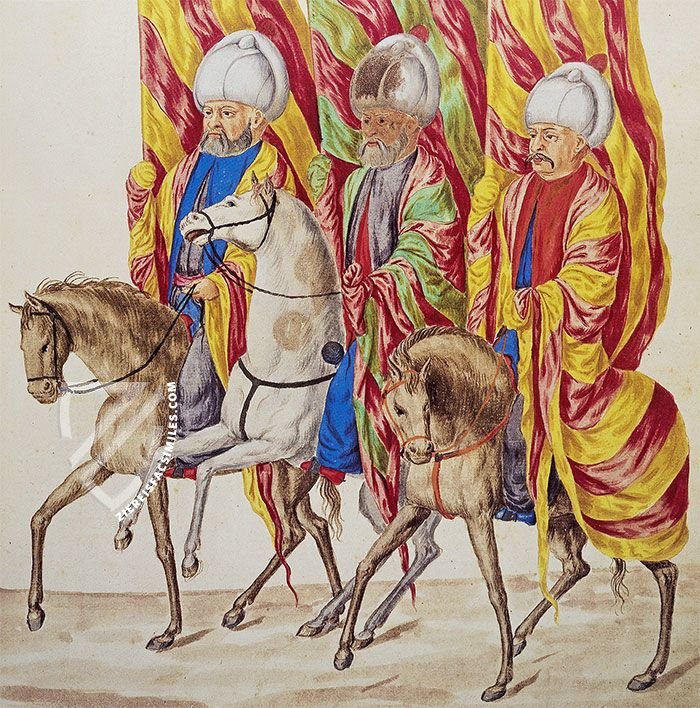
Costume Book of Lambert de Vos
Two Bulgari Women
The Bulgars were a nomadic Turkic people who settled along the steppe of the lower Volga during the 7th century and gradually moved west. They had a complex relationship with the Byzantines, initially acting as some of their greatest allies in the West, but later found themselves to be enemies of Constantinople. Conquered by the Turks in 1396, Bulgaria would not be independent until 1908.
This is a rare depiction of two women in floor-length dresses because they are commoners and Muslims to boot. One is holding a basket of eggs and has a more olive-complexion, while the one holding the flatbread is fairer – a reflection of the polyglot mix of Turkic, Iranian, Slavic, Thracian, Greek, and other peoples living under the Bulgari warrior elite.
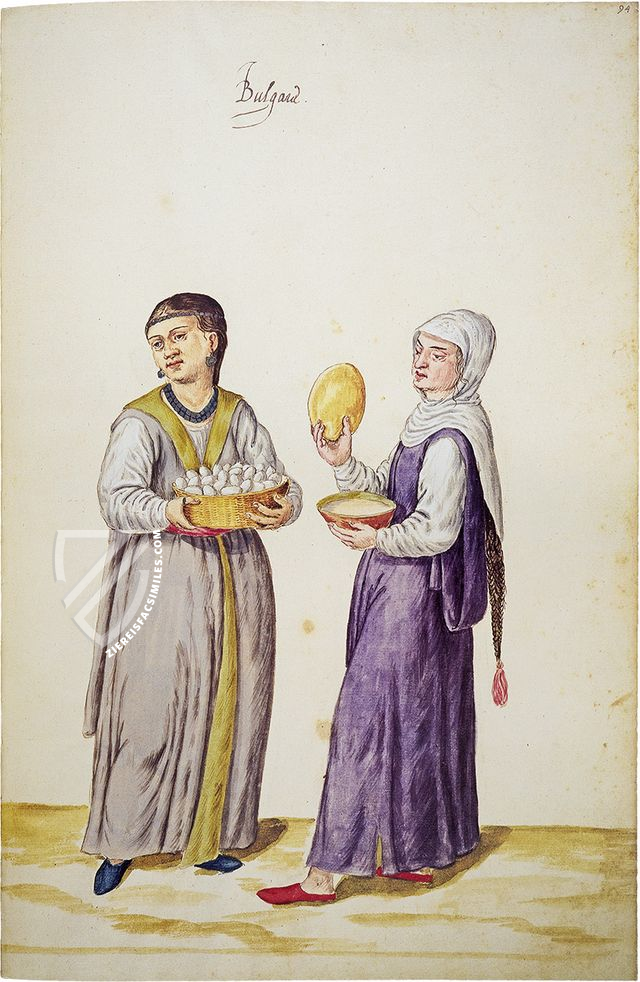
#1 Das Kostümbuch des Lambert de Vos
Language: German
(1,000€ - 3,000€)
- Treatises / Secular Books
- Apocalypses / Beatus
- Astronomy / Astrology
- Bestiaries
- Bibles / Gospels
- Chronicles / History / Law
- Geography / Maps
- Saints' Lives
- Islam / Oriental
- Judaism / Hebrew
- Single Leaf Collections
- Leonardo da Vinci
- Literature / Poetry
- Liturgical Manuscripts
- Medicine / Botany / Alchemy
- Music
- Mythology / Prophecies
- Psalters
- Other Religious Books
- Games / Hunting
- Private Devotion Books
- Other Genres
- Afghanistan
- Armenia
- Austria
- Belgium
- Colombia
- Croatia
- Czech Republic
- Denmark
- Egypt
- Ethiopia
- France
- Germany
- Hungary
- India
- Iran
- Iraq
- Israel
- Italy
- Japan
- Luxembourg
- Mexico
- Morocco
- Netherlands
- Peru
- Poland
- Portugal
- Russia
- Serbia
- Spain
- Sri Lanka
- Sweden
- Switzerland
- Syria
- Turkey
- Ukraine
- United Kingdom
- United States
- Uzbekistan
- Aboca Museum
- Ajuntament de Valencia
- Akademie Verlag
- Akademische Druck- u. Verlagsanstalt (ADEVA)
- Aldo Ausilio Editore - Bottega d’Erasmo
- Alecto Historical Editions
- Alkuin Verlag
- Almqvist & Wiksell
- Amilcare Pizzi
- Andreas & Andreas Verlagsbuchhandlung
- Archa 90
- Archiv Verlag
- Archivi Edizioni
- Arnold Verlag
- ARS
- Ars Magna
- ArtCodex
- AyN Ediciones
- Azimuth Editions
- Badenia Verlag
- Bärenreiter-Verlag
- Belser Verlag
- Belser Verlag / WK Wertkontor
- Benziger Verlag
- Bernardinum Wydawnictwo
- BiblioGemma
- Biblioteca Apostolica Vaticana (Vaticanstadt, Vaticanstadt)
- Bibliotheca Palatina Faksimile Verlag
- Bibliotheca Rara
- Boydell & Brewer
- Bramante Edizioni
- Brepols Publishers
- British Library
- C. Weckesser
- Caixa Catalunya
- Canesi
- CAPSA, Ars Scriptoria
- Caratzas Brothers, Publishers
- Carus Verlag
- Circulo Cientifico
- Club Bibliófilo Versol
- Club du Livre
- CM Editores
- Collegium Graphicum
- Collezione Apocrifa Da Vinci
- Comissão Nacional para as Comemorações dos Descobrimentos Portugueses
- Coron Verlag
- Corvina
- CTHS
- D. S. Brewer
- De Agostini/UTET
- De Schutter
- Deuschle & Stemmle
- Deutscher Verlag für Kunstwissenschaft
- DIAMM
- Droz
- E. Schreiber Graphische Kunstanstalten
- Ediciones Boreal
- Ediciones Grial
- Ediclube
- Edições Inapa
- Edilan
- Editalia
- Edition Georg Popp
- Edition Leipzig
- Edition Libri Illustri
- Editiones Reales Sitios S. L.
- Éditions de l'Oiseau Lyre
- Editions Medicina Rara
- Editorial Casariego
- Editorial Mintzoa
- Editrice Antenore
- Editrice Velar
- Edizioni Edison
- Egeria, S.L.
- Eikon Editores
- Electa
- Enciclopèdia Catalana
- Eos-Verlag
- Ephesus Publishing
- Eugrammia Press
- Extraordinary Editions
- Fackelverlag
- Facsimila Art & Edition
- Facsimile Editions Ltd.
- Facsimilia Art & Edition Ebert KG
- Faksimile Verlag
- Feuermann Verlag
- Folger Shakespeare Library
- Franco Cosimo Panini Editore
- Friedrich Wittig Verlag
- Fundación Hullera Vasco-Leonesa
- G. Braziller
- Gabriele Mazzotta Editore
- Gebr. Mann Verlag
- Gesellschaft für graphische Industrie
- Getty Research Institute
- Giovanni Domenico de Rossi
- Giunti Editore
- Graffiti
- Grafica European Center of Fine Arts
- Guido Pressler
- Guillermo Blazquez
- H. N. Abrams
- Harrassowitz
- Helikon
- Hendrickson Publishers
- Henning Oppermann
- Herder Verlag
- Hes & De Graaf Publishers
- Hoepli
- Hortus Deliciarum
- Houghton Library
- Hugo Schmidt Verlag
- Idion Verlag
- Il Bulino, edizioni d'arte
- ILte
- Imago
- Insel Verlag
- Instituto de Estudios Altoaragoneses
- Instituto Nacional de Antropología e Historia
- Istituto dell'Enciclopedia Italiana - Treccani
- Istituto Ellenico di Studi Bizantini e Postbizantini
- Istituto Geografico De Agostini
- Istituto Poligrafico e Zecca dello Stato
- Italarte Art Establishments
- J. Thorbecke
- Jan Thorbecke Verlag
- Johnson Reprint Corporation
- Jugoslavija
- Karl W. Hiersemann
- Kasper Straube
- Kaydeda Ediciones
- Konrad Kölbl Verlag
- Kurt Wolff Verlag
- La Liberia dello Stato
- La Linea Editrice
- La Meta Editore
- Lambert Schneider
- Landeskreditbank Baden-Württemberg
- Leo S. Olschki
- Les Incunables
- Library of Congress
- Libreria Musicale Italiana
- Lichtdruck
- Lito Immagine Editore
- Lumen Artis
- Lund Humphries
- M. Moleiro Editor
- Maison des Sciences de l'homme et de la société de Poitiers
- Manuscriptum
- Maruzen-Yushodo Co. Ltd.
- MASA
- McGraw-Hill
- Militos
- Millennium Liber
- Müller & Schindler
- National Library of Wales
- Neri Pozza
- Nova Charta
- Oceanum Verlag
- Odeon
- Orbis Mediaevalis
- Orbis Pictus
- Österreichische Staatsdruckerei
- Oxford University Press
- Pageant Books
- Parzellers Buchverlag
- Patrimonio Ediciones
- Pattloch Verlag
- PIAF
- Pieper Verlag
- Plon-Nourrit et cie
- Prestel Verlag
- Princeton University Press
- Prisma Verlag
- Priuli & Verlucca, editori
- Pro Sport Verlag
- Propyläen Verlag
- Pytheas Books
- Quaternio Verlag Luzern
- Reales Sitios
- Recht-Verlag
- Reichert Verlag
- Reichsdruckerei
- Riehn & Reusch
- Roberto Vattori Editore
- Rosenkilde and Bagger
- Roxburghe Club
- Salerno Editrice
- Sarajevo Svjetlost
- Schöck ArtPrint Kft.
- Scolar Press
- Scrinium
- Scripta Maneant
- Scriptorium
- Siloé, arte y bibliofilia
- SISMEL - Edizioni del Galluzzo
- Sociedad Mexicana de Antropología
- Sorli Ediciones
- Stainer and Bell
- Styria Verlag
- Sumptibus Pragopress
- Szegedi Tudomànyegyetem
- Taberna Libraria
- Tarshish Books
- Taschen
- Tempus Libri
- Testimonio Compañía Editorial
- Thames and Hudson
- The Clear Vue Publishing Partnership Limited
- The Facsimile Codex
- The Folio Society
- The Marquess of Normanby
- The Richard III and Yorkist History Trust
- Tip.Le.Co
- TouchArt
- TREC Publishing House
- TRI Publishing Co.
- Trident Editore
- Typis Regiae Officinae Polygraphicae
- Universidad de Granada
- University of California Press
- University of Chicago Press
- Urs Graf
- Vallecchi
- Van Wijnen
- VCH, Acta Humaniora
- VDI Verlag
- Verlag für Regionalgeschichte
- Verlag Styria
- Vicent Garcia Editores
- W. Turnowsky
- Wiener Mechitharisten-Congregation (Wien, Österreich)
- Wissenschaftliche Buchgesellschaft
- Xuntanza Editorial
- Zollikofer AG

